Image
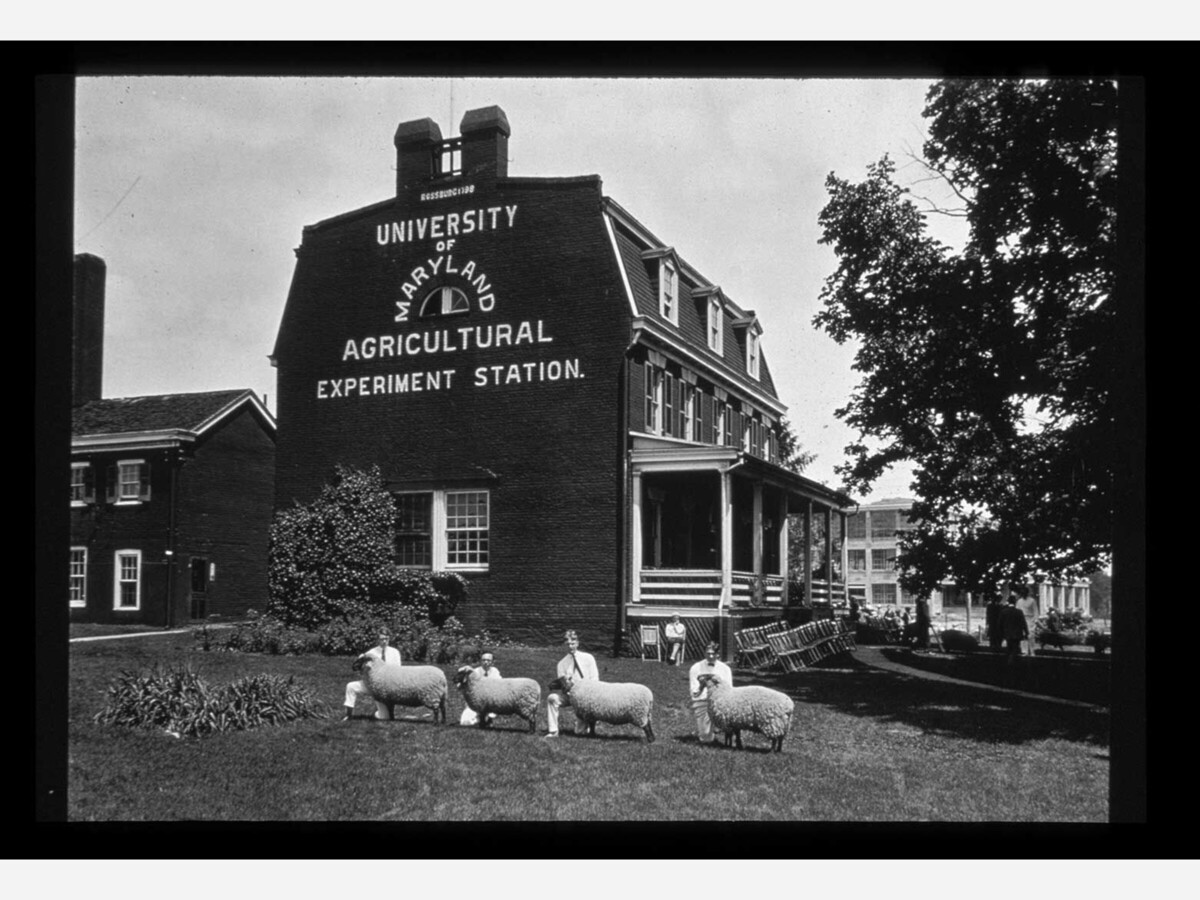
Entomology at the Maryland Agricultural College
By: Maureen Jones, University of Maryland
Maryland Agricultural College (MAC) was founded with the intent of providing farmers and their children with a robust, well-rounded education that emphasized cutting edge technologies and techniques to improve production efficiency and output. As much is evident from the faculty list and the subjects offered in MAC’s earliest days; though the institution aimed to produce graduates that were as educated in religion, ethics, philosophy, and language as the mechanical arts, they ultimately sought to instill these in students who would then go on to work in agriculture.1
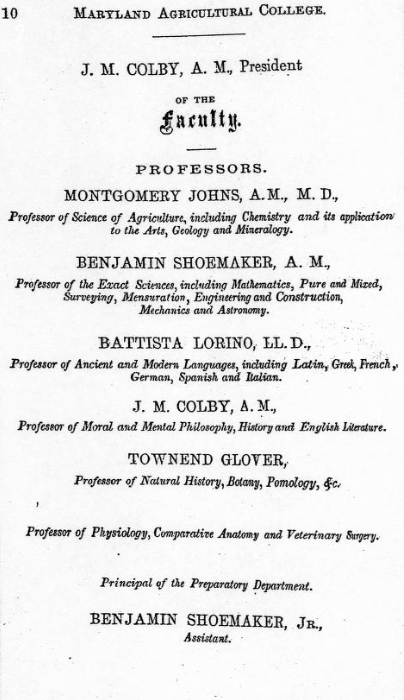
Much of the scientific research and instruction at MAC was centered around advancing agricultural production and efficiency. As such, entomology is one of the most well documented and successful fields of study, the instruction and research of which contributed to pest management in the farming industry. Classes allowed students to both work in the field and enhance their understanding of insect biology. Spraying orchards to control harmful insect populations was a regular undertaking for budding entomologists.34 Students studied insects from the inside out using diagrams, collections of pinned insects, and living insects from the fields maintained by the college.
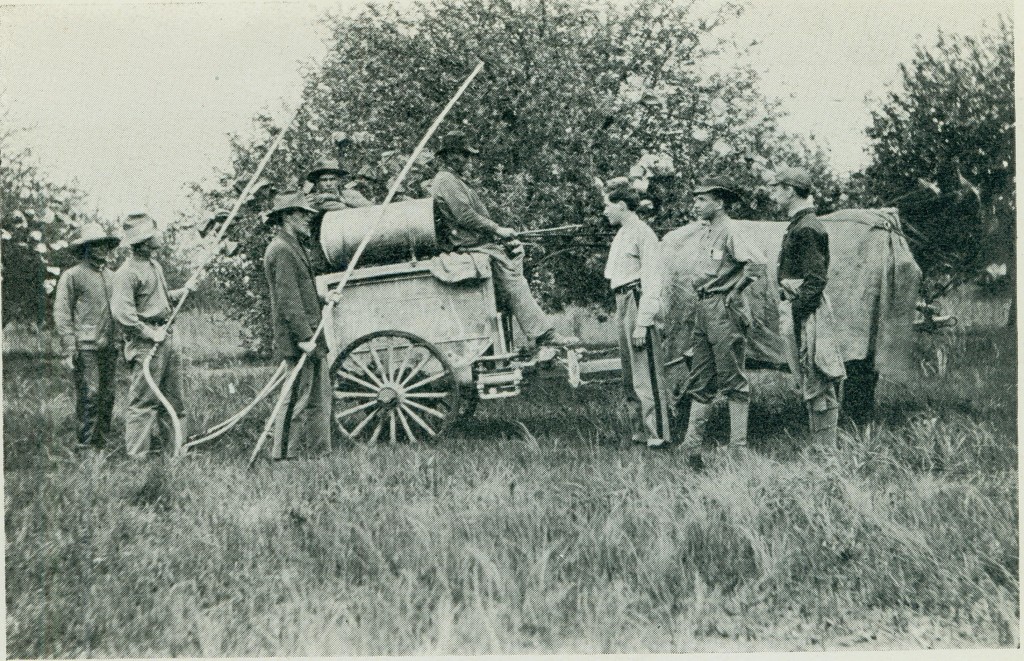
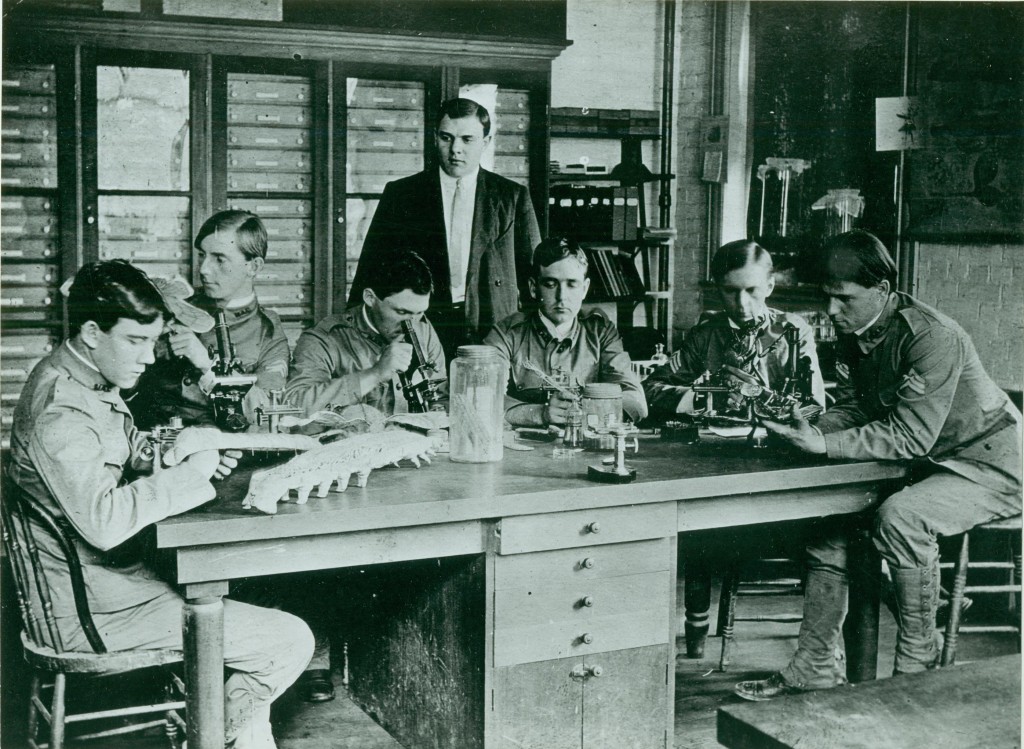
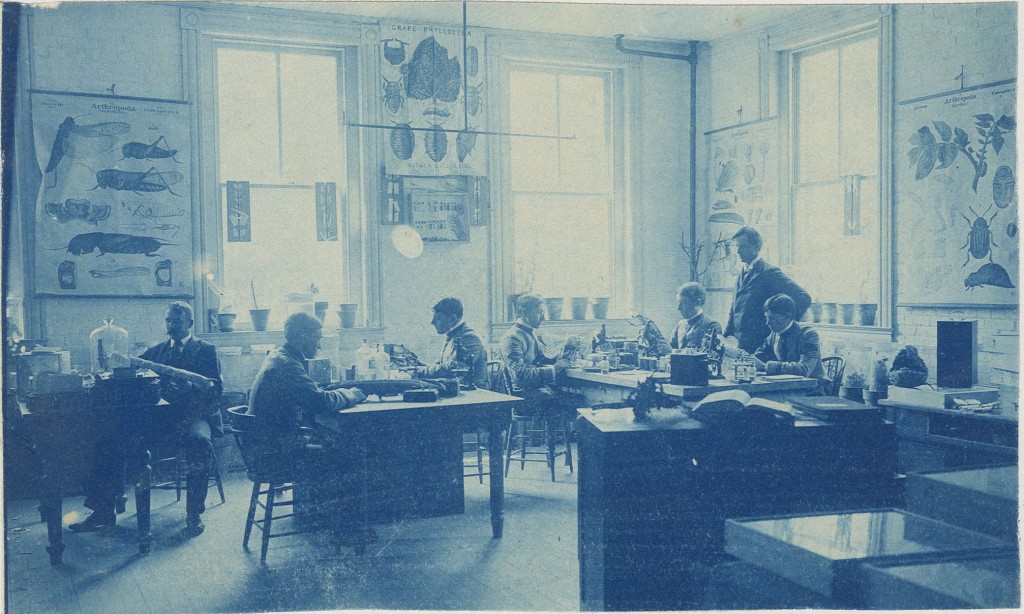
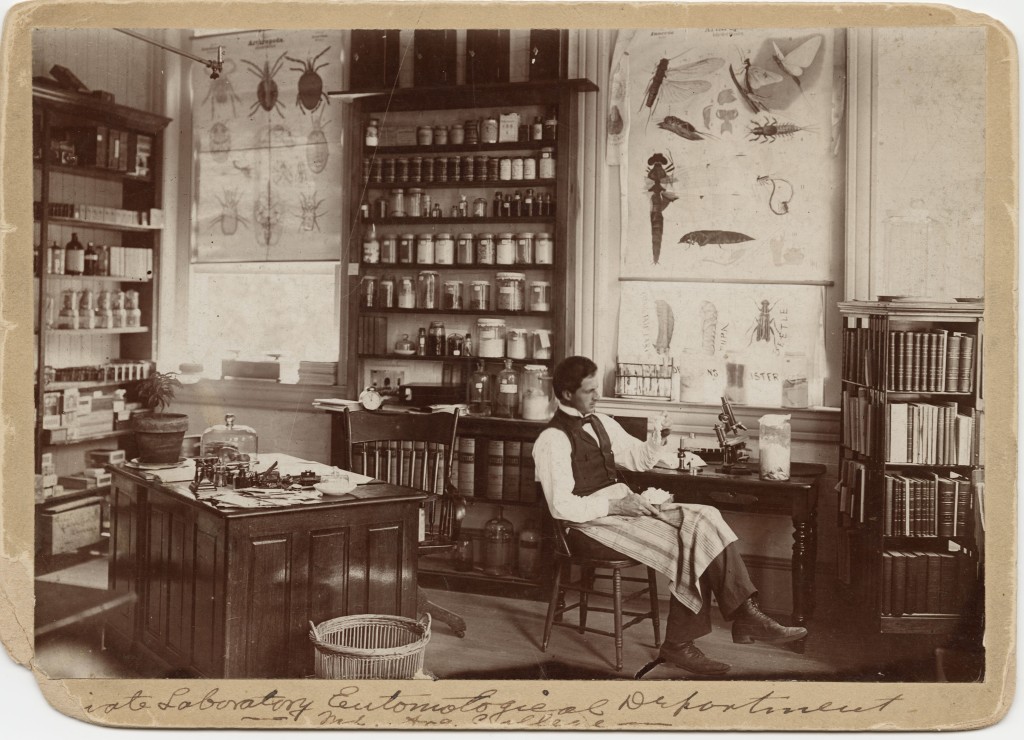
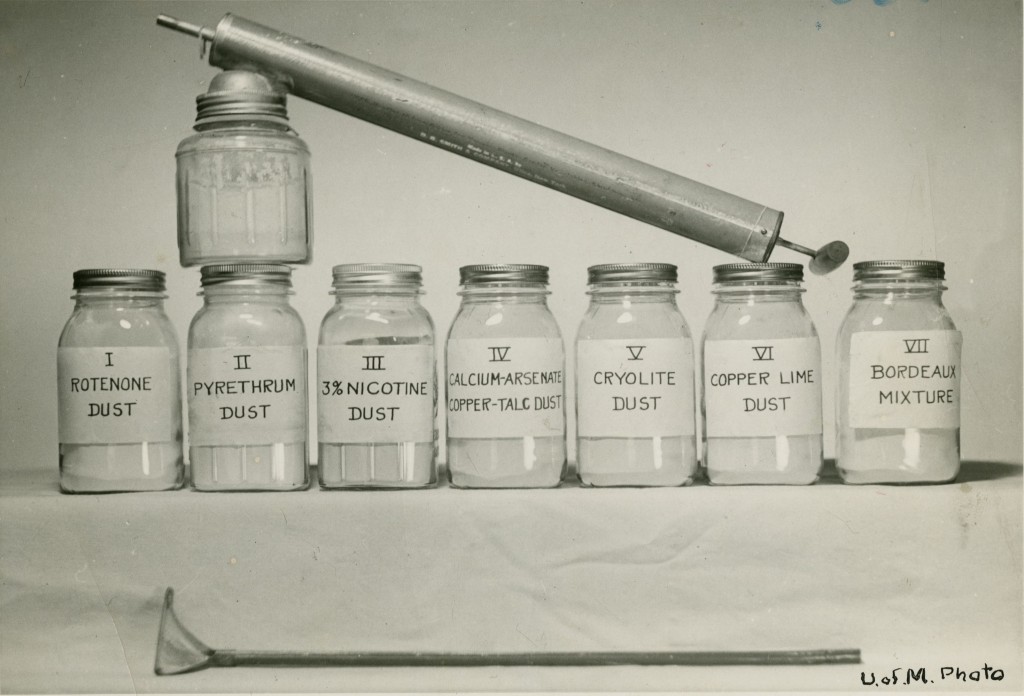
Top row, left to right: Students Spraying Trees from a Horse-Drawn Buggy in Entomology Class, 1910, Entomology lab, 1900, Entomology Lab, University of Maryland, circa 1899 (bottom). Bottom row, left to right: Entomological Lab, Maryland Agricultural College, 1899, Glass jars of pesticides and sprayer, undated.
Entomology was taught at MAC from the college’s inception, first by Townsend Glover. From 1876 to 1879, zoology instruction replaced entomology in the Division of Natural Sciences, which continued to instruct students on bees and beekeeping. By 1887, full entomological instruction was reinstated. The field grew in prominence and scope in the 1890s with the foundation of the Agricultural Experiment Station, and research on insects as agricultural pests began in earnest. It also ushered in the demand for a defined department for entomological studies, and the formal Entomology Department was formed in 1897.5
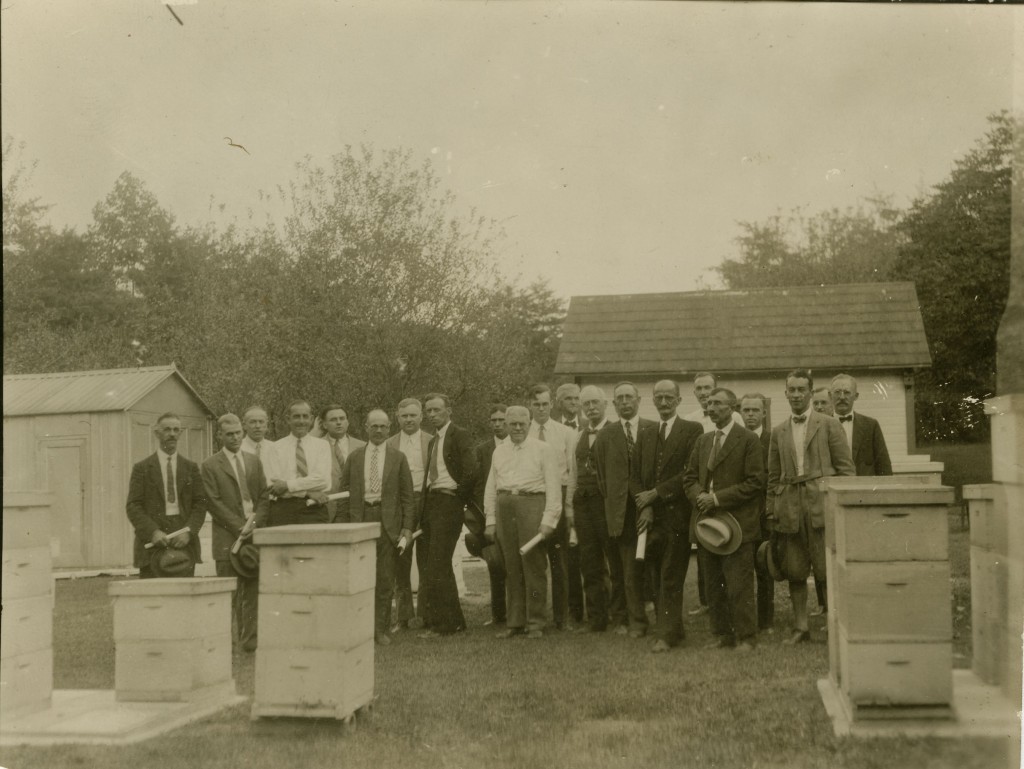
Beekeepers at Somerset, undated
Some of the most interesting entomology materials in the University Archives collections are three silkworm models produced by French naturalist Louis Auzoux, who was an expert in . These extremely detailed models were one of the teaching tools used in the instruction of invertebrate biology. They were created by 1880 at the latest, and were in use in MAC classrooms by 1900 at the latest- this is their first documented use in the curriculum. Auzoux’s anatomical models were anatomy clastiques, which meant that they opened to reveal interior anatomical details.6 Crafted from paper mache and finished with shiny egg tempura, Auzoux’s models were intended to be as affordable as they were accurate. He engaged in extensive study of each creature he produced, using them to create models that allowed students to see anatomical details that would be almost imperceptibly tiny on the animals they were based on.7 His highly sought after models were were one of the items that provided MAC entomology students with a quality education.
The first woman to graduate with a four year degree from MAC, Elizabeth Hook, received a degree in entomology. You can learn more about Elizabeth Hook in this 2020 blog post.
MAC secured a number of highly decorated entomology professors over the years, a testament to the caliber of education provided. In addition to being the first entomology professor at MAC, Glover was the first entomologist in the federal government, taking a position with the Bureau of Agriculture that would eventually be known as Entomologist of the United States. Glover was deeply interested in the artistic side of entomology. He made copper etchings of insects that were featured in Illustrations of North American Entomology as well as 2,000 models of fruits. His publication Manuscript Notes from My Journal was developed from a field journal he had created to help his students identify 200 different insects, which he also illustrated. His interests were not limited to illustration, however, and Glover would often take to the wooded areas and fields around campus to collect specimens, notes pertaining to which were then featured in reports published by the Commissioner of Agriculture.8








Willis G. Johnson was a professor of both entomology and invertebrate zoology, and is pictured in many of the earliest remaining images of MAC, including several of those pictured above. He wore a number of hats in his decorated career, including serving as Associate Editor of American Agriculturist and as the State Archivist of Maryland during his time instructing at MAC.9
In 1894, San Jose scale was discovered in Maryland. This insect is known for wreaking havoc on fruit trees, particularly apples and peaches. Johnson became the foremost expert in the true bug and contributed extensively to the Maryland Tree and Nursery Stock Law.10 In support of his campaign against San Jose scale, Johnson studied and developed fumigation methods for the control of pests in agricultural settings, the analysis of the use of hydrocyanic acid gas being one of his best known contributions to that effect.11 He believed that early recognition and prevention were the key to controlling the pest, and his work with fumigants is proof of such.
T.B. Symons was a graduate of MAC’s entomology program, and is featured in several of the above photographs. As an assistant of Johnson’s, he was also influential in the fight against San Jose scale, and the two toured Maryland orchards to document the devastation of San Jose scale. Together with F.H. Blodgett, he published a calendar of pest control measures and spray schedules for the Horticultural Society.12 He was particularly well known for his efforts in advancing the use of lime sulfur as a pest control spray, the effects of which were detailed in his publication “Lime-Sulfur as a Summer Spray.”13 Later, Symons went on to be State Entomologist, and he continued to teach entomology and zoology at MAC. In his lifetime, he was also the Head of the Department of Entomology, Secretary-Treasurer of the Maryland State Horticultural Society, a charter member of the Entomological Society of America, and the Director of Extension at the MAC Cooperative Extension Service.14 Between his schooling and professional work, T.B. Symons served MAC, then Maryland State College, then the University of Maryland, for seventy five years.
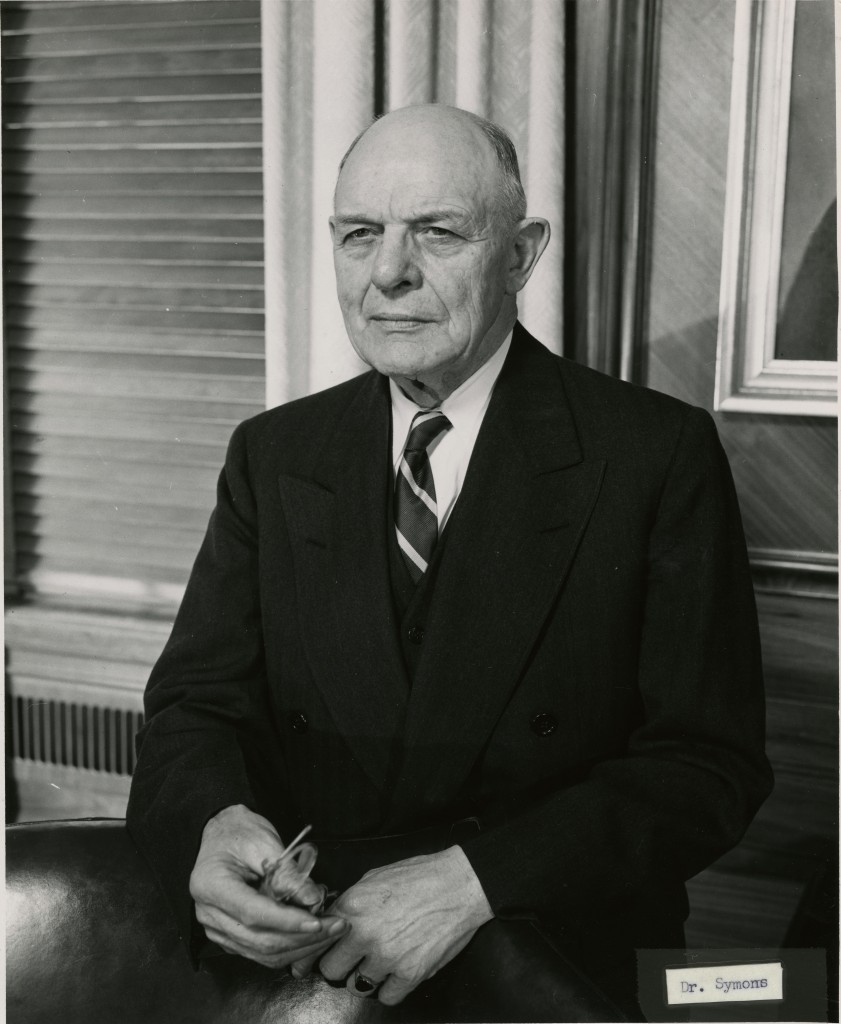
Formal photograph of Dr. Thomas B. Symons in the President’s Office, undated
In the 19th century, the Maryland Agricultural College’s future was contentious, and financial difficulties threatened the institution with closure. The success of entomological study there certainly helped keep it afloat, tying it to legislation and the scientific community. Entomology was a key component of the curriculum, presenting the opportunity for students to enhance their capacity to succeed in farming through pest control measures. The college’s labs and fields facilitated massive developments in the field, providing both botanical specimens and ample insect life for students and professors alike to study.
Works Cited
2: The Agricultural Experiment Station was the primary body for agricultural innovation on campus, and its contributions to the natural and biological sciences cannot be overstated. Its history is a robust topic in and of itself, and will be explored with more depth in future blog posts.
3: Maryland Agricultural College, “History — Agricultural Experiment Station, 1852-1915 and undated,” Box 7, Folder 2. Maryland Agricultural Experiment Station records, University of Maryland University Archives.
5. Bissell, Theo L. “History of Entomology at the University of Maryland.” Reprinted from Bulletin of the Entomological Society of America 6, no. 2 (June 1960): 80-81.
6: Bissell, Theo L. “History of Entomology at the University of Maryland.” Reprinted from Bulletin of the Entomological Society of America 6, no. 2 (June 1960): 81.
7: Cocks, Margaret Maria. “Dr Louis Auzoux and His Collection of Papier-Mâché Flowers, Fruits and Seeds.” Journal of the History of Collections 26, no. 2 (June 2014): 230-231. doi:10.1093/jhc/fht036
8. Bissell, Theo L. “History of Entomology at the University of Maryland.” Reprinted from Bulletin of the Entomological Society of America 6, no. 2 (June 1960): 80.
9. “Willis Grant Johnson,” Journal of Economic Entomology, Volume 1, Issue 2, 1 April 1908, Pages 163–164, https://doi.org/10.1093/jee/1.2.163
10. Bissell, Theo L. “History of Entomology at the University of Maryland.” Reprinted from Bulletin of the Entomological Society of America 6, no. 2 (June 1960): 80.
11: Willis Grant Johnson, Journal of Economic Entomology, Volume 1, Issue 2, 1 April 1908: 164, https://doi.org/10.1093/jee/1.2.163
12: Bissell, Theo L. “History of Entomology at the University of Maryland.” Reprinted from Bulletin of the Entomological Society of America 6, no. 2 (June 1960): 83.
13. Norton, J.B.S., and T.B. Symons. “Lime-Sulfur as a Summer Spra.” Maryland Agricultural Experiment Station Bulletin 164 (February 1912): 263–72. https://catalog.hathitrust.org/Record/011480558.
AdvertisementsREPORT THIS AD
14: Bissell, Theo L. “History of Entomology at the University of Maryland.” Reprinted from Bulletin of the Entomological Society of America 6, no. 2 (June 1960): 83.
Maureen Jones is a graduate student pursuing a Master’s of Library and Information Science from the University of Maryland iSchool as well as the Museum Studies and Material Culture Certificate. She is interested in museum studies, reparative justice in archives, taxidermy, and hockey.